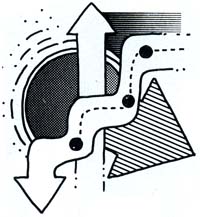 gameplay
gameplay
ORSON SCOTT CARD
Programming for Its Own Sake Can Lead to "One-Trick Pony" Games
Too many game designers think of themselves as programmers who happen to be writing games, as opposed to game designers who happen to be using computers.
It makes a difference. There is such a thing as a "programmer's programmer"the wizard who writes such deft and elegant code that other programmers gasp in awe at its brilliance. Too often, though, in the effort to dazzle fellow code masters, a programmer lets the program shape the game instead of letting the game shape the program.
Whole games are designed around one cool thing that a programmer has figured out. "Why do that?" you ask the game designer.
"Because I can," he answers. Programming is its own reward.
The result? One exciting graphic is the centerpiece of the game. The rest is just filler, hackwork, tossed in to showcase the star effect.
Sometimes it's good enough. Accolade's Bubble Ghost feels like such a game. A bubble floats lightly in the air. The player controls a ghost whose job is to send the bubble through a tricky obstacle course--by blowing at it.
The central effect is as good as it gets. When the ghost puffs, the bubble moves quickly at first, then slows down rapidly and hangs or drifts. It absolutely moves like a bubble.
But what of the game? It's a pretty standard scramble scenario. Figure out how to move the bubble past various needles, fans, vacuums, and so on. Not since Centipede have we seen a game whose action makes so little sense-a rocket shooting at bugs? A ghost blowing a bubble through a maze? What for?
Oh, don't be such a spoilsport. It's fun, for a while at least, if only because nobody has simulated a bubble before. But once the novelty has worn off, it's just a pretty good game (which isn't anything to sneeze at - half the games published each year don't even achieve that).
Why does Bubble Ghost exist? I wouldn't be at all surprised if it began with some programmer figuring out how to simulate a bubble's movements. Other programmers loved it. Then somebody said, "Well, what are you going to do with it?" That's benign enough, really. But sometimes Programming for Its Own Sake leads to really dumb decisions.
CGA graphics on the IBM, for instance. That purple, green, and cyan screen is the palette from hell. It's so bleak that looking at it makes me thirsty.
It's even worse when compared to a computer with good graphics. On the Amiga, the Bubble Ghost bubble looks so light and airy you keep looking around for the kid with the bubble blower. On the CGA screen, the bubble might as well be made of brick. No wonder programmers would rather see their IBM-compatible games displayed on the EGA screen.
But why have the designers at Koei decided to release their new Genghis Khan in EGA only, cutting off most IBM owners? While Genghis Khan is pretty in EGA, there's nothing in it that wouldn't have played just as well in CGA. Apparently the programmers have taken over.
I haven't become proficient enough at Genghis Khan to give it a real review yet. But I've played enough to recognize other signs of "cool programming" at the expense of playability.
One of the great drawbacks of historical simulation in board games is sheer tedium. The more detailed the simulation, the more unbearably slow the game. Every turn takes forever. The only thing that keeps you playing is the knowledge that if you don't finish the thing, 22 hours of setup time will have been wasted.
Computers are supposed to change all that, right? Setup takes only moments, and the computer speeds the flow of the game. Chris Crawford proved it could be brilliantly done with his Eastern Front. And Koei's own Romance of the Three Kingdoms took the form to new heights-exquisite simulation with almost effortless play.
But with Genghis, the tedium is back. For instance, if you want to make money, you have to sell your territory's trade goods to any of three merchants. But you can't call all three merchants onto the screen at the same time. Nor can you barter with them. The result is endless flipping from screen to screen, and for what? The decisions are obvious; the computer could have made them all-in the background.
Maybe some of you will like all this detail for detail's sake. If so, have I got a game idea for you. It's called Journey, and is it realistic! You get to make your character take every step. You press L for left and R for right. Between each pair of steps, you select Speed and Length of Stride. But watch out for the deadly Untied Shoelace. Some fun, eh?